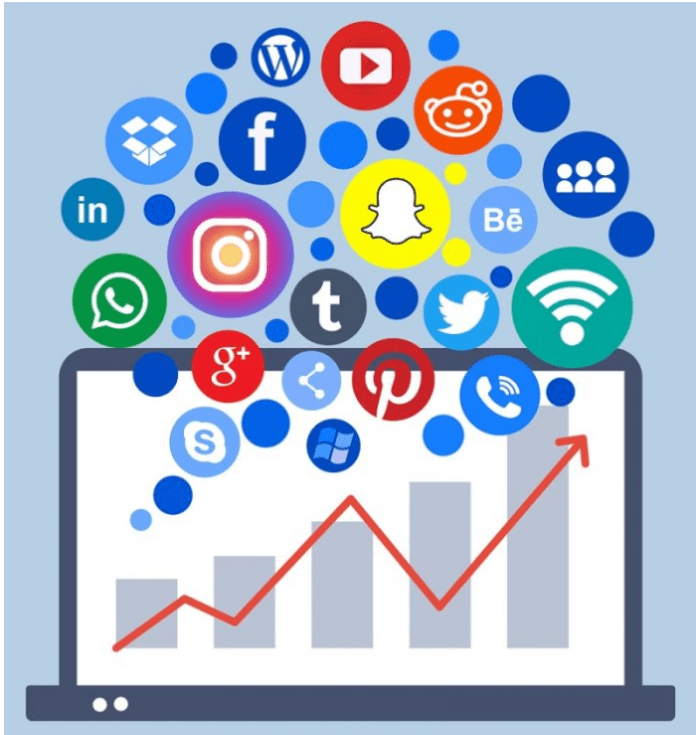Digital branding has become an indispensable part of modern business strategy. In today’s competitive marketplace, establishing and maintaining a strong online presence is essential for building trust, connecting with target audiences, and driving revenue. This comprehensive article explores the top digital platforms for effective branding, examines best practices for maximizing your brand’s online visibility, and provides practical insights into leveraging diverse digital channels. Whether you’re a startup or an established enterprise, understanding these platforms and their unique benefits can empower you to make informed decisions and foster lasting relationships with your customers.
In the digital age, traditional marketing methods are quickly being supplanted by digital strategies that offer measurable results, rapid communication, and cost-effective outreach. Digital platforms provide brands with the tools to create engaging content, interact directly with consumers, and tailor messaging to specific audience segments. With the proliferation of social media, video-sharing networks, blogs, email campaigns, and e-commerce solutions, businesses now have unprecedented opportunities to build a recognizable identity and stand out in crowded markets.
Digital branding is more than just a logo or tagline—it’s a holistic approach that encompasses every online interaction your audience has with your business. This includes your website’s design, social media profiles, content marketing efforts, search engine optimization (SEO), and online advertisements. Each of these elements plays a vital role in shaping the perception of your brand and driving long-term success.
The importance of a robust digital branding strategy cannot be overstated. Not only does it contribute to greater visibility and credibility, but it also directly impacts your return on investment (ROI) by increasing conversion rates and customer loyalty. As businesses increasingly shift their focus to online channels, understanding the nuances of different digital platforms is key to staying ahead of the curve.
The Importance of Digital Branding
Digital branding is a strategic process that involves creating a unique image and voice for your company in the online world. The benefits of a strong digital brand include:
- Increased Visibility: An optimized digital presence makes it easier for potential customers to discover your brand via search engines and social media.
- Enhanced Credibility: Consistent messaging and professional presentation build trust with consumers.
- Stronger Customer Relationships: Digital channels allow for two-way communication, enabling you to engage with your audience in real time.
- Competitive Advantage: A distinct digital identity helps you differentiate your business from competitors.
- Measurable Results: Tools like analytics and performance metrics provide insights into what is working and where improvements are needed.
With these advantages in mind, businesses are investing more in digital branding efforts. The following sections detail the various digital platforms that can transform your branding strategy and help you harness the full potential of the online space.
Overview of Top Digital Platforms
Digital platforms span a wide range of tools and channels, each offering unique opportunities for branding. The most influential platforms include:
Social Media Platforms
Social media has revolutionized the way brands communicate with their audiences. It offers interactive, real-time engagement, enabling companies to share stories, launch campaigns, and build communities around their products and services. Key platforms include:
- Facebook: With billions of active users, Facebook remains a powerful tool for community building and targeted advertising.
- Instagram: Known for its visual appeal, Instagram is ideal for brands looking to showcase products through high-quality images and short videos.
- Twitter: This fast-paced platform is perfect for real-time updates, customer service, and engaging in trending conversations.
- LinkedIn: As a professional networking site, LinkedIn is best suited for B2B branding, thought leadership, and industry-specific networking.
- TikTok: With its creative and viral short-form videos, TikTok is quickly becoming a favorite among younger demographics for authentic brand storytelling.
Website and Blogging Platforms
Your website is often the first point of contact for potential customers. A well-designed website not only enhances credibility but also provides a centralized hub for your brand’s content. Blogging platforms play a crucial role in content marketing, helping to boost SEO and establish your brand as an authority in your industry. Popular platforms include:
- WordPress: Known for its flexibility and extensive plugin ecosystem, WordPress is a favorite for creating customizable websites and blogs.
- Wix: This user-friendly platform offers drag-and-drop design tools for businesses that need to set up a professional website quickly.
- Squarespace: With elegant templates and robust e-commerce features, Squarespace is ideal for creative professionals and small businesses.
Video and Multimedia Platforms
Video content is one of the most engaging forms of digital media. It allows brands to tell stories in dynamic, visually appealing ways. Platforms that host video content include:
- YouTube: The world’s largest video-sharing platform, YouTube is essential for brands looking to create educational, promotional, or entertaining video content.
- Vimeo: Known for its high-quality video playback and creative community, Vimeo is a great choice for filmmakers and artists.
- Twitch: Initially focused on live streaming for gamers, Twitch now attracts a broader audience with its interactive live video content.
Email Marketing Platforms
Email remains one of the most effective tools for nurturing customer relationships. It allows brands to deliver personalized messages, promote products, and share valuable content directly with their audience. Leading platforms include:
- Mailchimp: Known for its ease of use and comprehensive features, Mailchimp is popular among small businesses for managing email campaigns.
- Constant Contact: With robust analytics and customer support, Constant Contact is ideal for businesses that need reliable email marketing solutions.
- Sendinblue: Offering both email and SMS marketing capabilities, Sendinblue is a versatile tool for multi-channel communication.
Online Advertising and SEO Platforms
Effective digital branding also relies on online advertising and search engine optimization. These strategies help drive traffic to your website and increase brand awareness. Essential platforms include:
- Google Ads: A cornerstone of online advertising, Google Ads enables you to target customers through search, display, and video ads.
- Bing Ads: An alternative to Google Ads, Bing Ads can be valuable for reaching a different segment of search engine users.
- SEO Tools: Platforms like SEMrush, Ahrefs, and Moz provide insights into keyword performance, competitor strategies, and website optimization techniques.
In-Depth Analysis of Social Media Platforms
Social media platforms offer diverse features that can be tailored to suit different branding needs. Here, we take a closer look at each major platform and discuss strategies for leveraging them effectively.
Facebook remains a dominant force in the digital landscape. Its vast user base and powerful advertising tools make it indispensable for brands looking to reach a wide audience. Key benefits of Facebook include:
A. Targeted Advertising: Facebook’s sophisticated algorithms allow you to target specific demographics based on age, location, interests, and behavior.
B. Community Building: Facebook Groups and Pages enable you to create dedicated communities around your brand, fostering engagement and loyalty.
C. Content Diversity: With support for text, images, videos, and live streams, Facebook lets you share a variety of content types to keep your audience engaged.
To maximize your branding efforts on Facebook, focus on creating high-quality, shareable content and leveraging analytics to refine your strategy continuously.
Instagram’s visual-first approach makes it an excellent platform for brands that rely heavily on imagery. Whether you’re showcasing products or telling a visual story, Instagram can help you capture the imagination of your audience.
A. High-Quality Visuals: Invest in professional photography and design to make your content stand out.
B. Stories and Reels: Use Instagram Stories and Reels to share behind-the-scenes glimpses and timely updates that engage your audience in a more informal setting.
C. Influencer Partnerships: Collaborate with influencers who align with your brand values to reach new audiences and build credibility.
Engaging regularly with followers through comments, likes, and direct messages also plays a critical role in fostering a loyal community on Instagram.
Twitter’s fast-paced environment is ideal for brands that thrive on timely updates and real-time engagement. It is particularly effective for customer service and public relations.
A. Real-Time Updates: Use Twitter to share news, product launches, and event announcements instantly.
B. Engagement Through Hashtags: Participate in trending topics and create branded hashtags to increase visibility and encourage user-generated content.
C. Customer Interaction: Respond promptly to customer inquiries and feedback to build a positive brand reputation.
Using Twitter analytics can help you identify which tweets generate the most engagement, allowing you to optimize your messaging over time.
For businesses operating in the B2B space, LinkedIn is an invaluable tool for professional networking and thought leadership. It offers numerous features that can elevate your brand among industry peers and potential clients.
A. Professional Networking: Connect with industry leaders, potential clients, and partners through LinkedIn’s extensive networking features.
B. Content Sharing: Publish articles, share case studies, and participate in industry discussions to establish your brand as an authority.
C. Targeted Advertising: Use LinkedIn’s advertising tools to reach decision-makers and professionals who are most likely to benefit from your products or services.
A well-crafted LinkedIn profile and consistent engagement can significantly enhance your brand’s credibility in the professional realm.
TikTok
TikTok has rapidly gained popularity, especially among younger demographics, due to its creative and engaging short-form video content. For brands willing to experiment with innovative content, TikTok presents a unique opportunity.
A. Creative Storytelling: Use TikTok’s unique video format to create fun, engaging content that resonates with a younger audience.
B. Viral Challenges: Participate in or create viral challenges to boost brand visibility and encourage user participation.
C. Authenticity: Embrace the platform’s informal style by showcasing behind-the-scenes content and authentic brand stories.
By understanding TikTok’s trends and engaging with its community, brands can tap into a vibrant ecosystem of creative expression.
Leveraging Video and Multimedia Platforms
Video content is one of the most powerful tools in a digital marketer’s arsenal. Videos can convey complex information in a digestible format, evoke emotions, and drive engagement. Here’s how to harness the power of video platforms:
YouTube
YouTube is the undisputed leader in video content, offering brands an extensive audience and robust tools for content creation and monetization.
A. Educational Content: Create tutorials, how-to guides, and product demonstrations that help your audience understand your offerings.
B. Storytelling: Use narrative-driven videos to build an emotional connection with viewers.
C. Live Streaming: Engage with your audience in real time through live streams, Q&A sessions, and product launches.
A consistent posting schedule and high-quality production can help build a dedicated following on YouTube.
Vimeo and Twitch
While Vimeo is known for its creative community and high production quality, Twitch offers live streaming solutions that enable interactive content. Both platforms cater to niche audiences and can be particularly useful for brands with specific creative or gaming-related focuses.
A. Vimeo: Ideal for showcasing polished video content, including short films, advertisements, and artistic projects.
B. Twitch: Use Twitch to host live events, behind-the-scenes sessions, and interactive streams that allow viewers to engage directly with your brand.
By leveraging these platforms, brands can create varied multimedia experiences that appeal to different segments of their audience.
Harnessing the Power of Content Marketing and Blogging
Content marketing through blogs and articles is a cornerstone of digital branding. A well-maintained blog not only improves your SEO ranking but also positions your brand as an industry expert.
Building an Effective Blog
A robust blog strategy involves more than simply publishing posts. It requires careful planning, consistent quality, and a focus on audience needs.
A. SEO Optimization: Use targeted keywords and optimize meta descriptions to improve search engine rankings.
B. Value-Driven Content: Produce in-depth articles that provide real value to readers, addressing their pain points and questions.
C. Regular Updates: Consistently update your blog with fresh content to keep your audience engaged and improve your site’s overall ranking.
Incorporating multimedia elements like images, infographics, and videos can also enhance the readability and shareability of your blog posts.
Utilizing Guest Posting and Collaborative Content
Expanding your reach through guest posting and content collaborations can introduce your brand to new audiences. Partner with industry influencers and bloggers to create mutually beneficial content that drives traffic back to your website.
A. Identify Influencers: Seek out individuals or organizations that share similar values and target demographics.
B. Co-Create Content: Collaborate on articles, interviews, or video content that highlights both parties’ expertise.
C. Leverage Cross-Promotion: Use social media and email marketing to promote the collaborative content and maximize its reach.
Email Marketing: Nurturing Relationships One Message at a Time
Email marketing remains a highly effective channel for digital branding. It offers a direct line of communication with your audience and can be personalized to meet their specific interests and needs.
Strategies for Effective Email Marketing
A comprehensive email marketing strategy involves segmentation, personalization, and consistent value delivery.
A. Segmentation: Divide your audience into groups based on demographics, behavior, and interests to tailor your messaging effectively.
B. Personalization: Use personalized subject lines and content to make recipients feel valued and understood.
C. Consistent Value: Provide useful content, exclusive offers, and regular updates that keep your audience engaged and informed.
By integrating analytics and performance tracking, you can continually refine your email campaigns to better serve your audience.
Online Advertising and SEO: Driving Traffic and Enhancing Visibility
A robust digital branding strategy combines organic and paid methods to drive traffic and ensure your brand remains visible online.
Online Advertising Platforms
Paid advertising platforms like Google Ads and Bing Ads enable you to reach a targeted audience based on specific search queries and browsing behaviors.
A. Google Ads: With its vast network and sophisticated targeting options, Google Ads allows you to run search, display, and video campaigns that drive immediate results.
B. Bing Ads: While often overlooked, Bing Ads can complement your Google strategy by reaching a different segment of users who use alternative search engines.
Investing in online advertising can provide quick visibility, while continuous optimization based on analytics ensures a positive return on investment.
Mastering SEO for Long-Term Success
SEO is a long-term strategy that helps improve your website’s visibility and authority. By optimizing your content for search engines, you can attract organic traffic and build a sustainable online presence.
A. Keyword Research: Identify and target keywords relevant to your industry and audience.
B. Quality Content: Create informative, engaging, and original content that addresses your audience’s needs.
C. Technical Optimization: Ensure that your website is fast, mobile-friendly, and easy to navigate, which are critical factors for search engine rankings.
Using SEO tools and monitoring industry trends can help you stay ahead of the competition and adjust your strategy as needed.
Choosing the Right Platform for Your Brand
With a plethora of digital platforms available, selecting the ones that align with your business goals and target audience is crucial. Consider the following factors when making your decision:
A. Target Audience: Analyze where your customers spend their time online. Different demographics may favor different platforms.
B. Content Format: Consider the type of content that best represents your brand—be it video, written articles, images, or live interactions.
C. Budget and Resources: Determine the amount of time and money you can invest in managing each platform effectively.
D. Business Objectives: Align your platform strategy with your overall business goals, whether that’s increasing brand awareness, driving sales, or building a community.
E. Analytics and Feedback: Utilize performance metrics to gauge success and adjust your strategy based on what works best.
By evaluating these factors, you can create a focused strategy that maximizes the return on your digital branding efforts.
Emerging Trends in Digital Branding
The digital landscape is continuously evolving, and staying ahead means keeping an eye on emerging trends and technologies. Some of the current trends include:
A. Influencer Marketing: Collaborating with influencers can amplify your brand’s reach and credibility.
B. Interactive Content: Augmented reality (AR), virtual reality (VR), and interactive web experiences are becoming more mainstream, offering novel ways to engage audiences.
C. Voice Search Optimization: As voice-activated devices become more common, optimizing content for voice search is crucial for staying relevant.
D. Personalization at Scale: Advances in artificial intelligence (AI) and machine learning enable highly personalized user experiences across digital platforms.
Embracing these trends can give your brand a competitive edge and help you connect with your audience in innovative ways.
Best Practices for Digital Branding
To ensure the success of your digital branding efforts, consider implementing the following best practices:
A. Consistency is Key: Maintain a consistent brand voice, visual style, and messaging across all digital platforms.
B. Engage Authentically: Focus on building genuine relationships with your audience by engaging in meaningful conversations and responding promptly to feedback.
C. Invest in Quality: Whether it’s content creation, website design, or customer service, investing in quality builds trust and credibility.
D. Measure and Adapt: Use analytics to track performance, identify areas for improvement, and adapt your strategy as needed.
E. Stay Updated: Regularly research industry trends and technological advancements to keep your branding efforts current and effective.
Adhering to these best practices will not only enhance your online presence but also foster long-term loyalty and growth.
Conclusion
In the modern digital landscape, effective branding is a multifaceted endeavor that requires strategic planning, a deep understanding of various digital platforms, and a commitment to continuous improvement. From social media and video-sharing sites to blogging, email marketing, and online advertising, each digital platform offers unique advantages that can be harnessed to build a strong, recognizable brand. By leveraging these platforms and implementing best practices for digital branding, businesses can achieve increased visibility, credibility, and customer engagement.
Whether you are just starting your digital journey or looking to refine your existing strategy, understanding the nuances of each platform is essential. Embrace the evolving nature of digital technology, stay true to your brand values, and continuously measure your efforts to stay ahead of the competition. Ultimately, effective digital branding is not just about being seen—it’s about creating lasting connections with your audience and driving sustainable growth.











